When satellite television hit the market, domestic satellite dishes were very expensive metal units, which occupied a large space in the garden.
In those early years, only the toughest TV fans faced the job and the cost of installing their own satellite dish. Satellite TV was much more difficult to broadcast than cable TV.
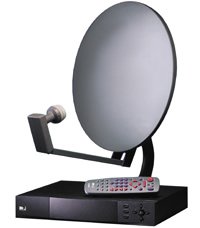
Nowadays, you see compact satellite dishes installed on ceilings everywhere. Drive through rural areas beyond the reach of cable companies and you will find satellite dishes in almost every home. The leading satellite television companies are winning more and more customers every day with the lure of films, sporting events and news from around the world.
In this article, we will discover everything that satellite TV does, from the TV station to the TV.
The problem of TV broadcasting
Conceptually, satellite television is very similar to ordinary television broadcasting. It is a wireless system for delivering television programming directly to the viewer’s home. Both television and satellite broadcast stations send programming via a radio signal.
Broadcast stations use a powerful antenna to send radio waves through the surrounding area. Viewers can pick up the signal with a much smaller antenna. The main limitation of television broadcasting is range. The radio signals used in the television broadcast propagate from the transmitting antenna in a straight line. To receive these signals, you must be in the “line of sight” direct from the antenna. Small obstacles like trees or small buildings are not a problem, but a large obstacle, like Earth, will reflect these radio waves.
If the Earth were perfectly flat, you could pick up the television broadcast thousands of kilometers from the source. But because the planet is curved, it ends up interrupting the line of sight of the signal. The other problem with television broadcasting is that the signal is often distorted, even in the image receiving area. To get a perfectly clear signal like the one you find on cable, you have to be very close to the broadcasting antenna, without many obstacles in the way.
Satellite television solves the problems of range and distortion by transmitting signals from satellites that orbit the Earth. Since satellites are high in the sky, there are many more customers in the line of sight. Satellite television systems transmit and receive radio signals using specialized antennas called satellite dishes .
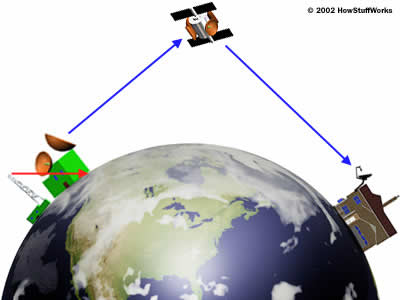
Satellites are much higher in the sky than TV antennas, so they have a much greater “line of sight” range
The television satellites are all in geosynchronous orbit , which means that they remain in a location in the sky relative to Earth. Each satellite is launched into space at approximately 11,000 km / h and reaches approximately 35,700 km above the Earth. At this speed and altitude, the satellite will circle the planet once every 24 hours, the same period that the Earth takes to make a complete rotation. In other words, the satellite exactly follows the pace of our planet’s movement. That way, you only need to direct the dish to the satellite once, and from there it picks up the signal without further adjustments, at least as long as everything works fine.
Essentially, this is what satellite television is all about. But, as we will see below, there are several important steps between the source of the original programming and your television.
The global system
The first viewers of satellite TV were a kind of explorer. They used their parabolic faces to discover exclusive programming that was not necessarily intended for mass audiences. The satellite dish and receiver equipment provided viewers with the tools to pick up foreign stations, live broadcasts between different broadcast stations, NASA activities and various other things broadcast via satellites.
Some satellite TV owners still seek this type of programming on their own. But today, most satellite TV customers get their programming from a provider direct broadcast satellite (direct broadcast satellite or DBS) such as Sky, Via Embratel OiTV etc. The provider selects programs and transmits them to subscribers as an established package. Basically, the provider’s goal is to bring dozens or even hundreds of channels to your television in a way that brings competition to cable TV closer. Unlike early programming, the broadcast provider is completely digital , which means much better image and sound quality.
Initially, satellite television was broadcast on the C radio band, a frequency range between 3.4 GHz and 7 GHz. The digital broadcast satellite sends programming in the Ku frequency range (12 GHz to 14 GHz).
There are five main components involved in a direct to home (DTH) satellite system : the programming source, the broadcast center, the satellite, the satellite dish and the receiver.
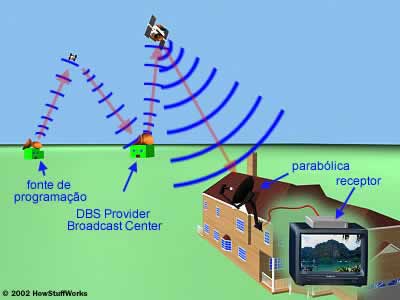
- Programming sources are simply the channels that provide programming for the broadcast. The provider does not create an original schedule. It pays other companies (HBO, for example, or ESPN) for the right to broadcast content provided via satellite. In this way, the provider is like a broker between you and the actual programming sources. Cable television companies operate on the same principle.
- The transmission center is the central link of the system. At the broadcast center, the television provider receives signals from various programming sources and radiates a broadcast signal to satellites in geostationary orbit.
- The satellites receive the signals from the transmission station and relay it to the ground.
- The viewer’s satellite dish picks up the signal from the satellite (or multiple satellites in the same region of the sky) and sends it to the receiver at the viewer’s home.
- The receiver processes the signal and sends it to a regular television set.
The programation
Satellite TV providers obtain programming from two main sources: national permanent channels (such as HBO, ESPN and CNN) and several local channels (NBC, CBS, ABC, PBS and Fox affiliates in a particular area). Most permanent channels also offer programming for cable television, and local channels typically broadcast their programming by broadcasting.
Permanent channels usually have a distribution center that sends their programming to a geostationary satellite. The broadcast center uses large satellite dishes to pick up these analog and digital signals from various sources.
Most local stations do not broadcast their programming to satellites, and the provider needs to obtain it in another way. If the provider includes local programming in a particular area, it will have a small installation consisting of a few racks of communications equipment. The equipment receives local signals directly from the transmitter through a fiber optic cable or an antenna and then transmits them to the central transmission center.
The transmission center converts all of this programming into a high-quality, uncompressed digital stream. At that point, the stream contains a vast amount of data, about 270 megabits per second (Mbps) for each channel. In order to transmit it from there, the transmission center needs to compress the signal. Otherwise, it would be too big for the satellite to handle.
Compression
The two largest providers in the United States use the MPEG-2 compressed video format , the same used to store movies on DVDs. With MPEG-2 compression, the provider can reduce the stream from 270 Mbps to about 5 or 10 Mbps ( depending on the type of programming). This is the fundamental step that made the DBS service a success. With digital compression, a typical satellite can transmit about 200 channels. Without digital compression, it can transmit only 30 channels.
At the transmission center, the high-quality digital video stream passes through an MPEG-2 encoder, which converts the programming to MPEG-2 video of the correct size and format for the satellite receiver in your home.
The MPEG encoder analyzes each frame and decides how to encode it. The encoder eliminates redundant or irrelevant data and extrapolates information from other frames to reduce the total file size. Each frame can be encoded in one of three ways:
- as an intraframe – an intraframe contains the complete image data for the entire frame. This encoding method provides the least compression.
- as a predicted frame – a predicted frame contains just enough information to tell the satellite how to display the frame based on the most recently displayed intraframe or frame. This means that the frame contains only the data that relates how the image was changed from the previous frame.
- as a bidirectional frame – to display a bidirectional frame, the receiver must have information from the surrounding frame or predicted frames. Using the data from the nearest surrounding frames, the receiver interpolates the position and color of each pixel.
This process occasionally produces ” artifacts “, which are small signal errors in the video image. However, for most of the transmission, it generates a clear and sharp image.
The compression rate depends on the nature of the schedule. If the encoder converts a newscast, it can use many more predicted frames because most of the scene will remain the same from one frame to the next. In other types of programming, such as action films and video clips, things change very quickly and the encoder will need to create more intraframes. As a result, something like a newscast can be compressed to a much smaller size than something like an action movie.
Encryption and transmission
After the video is compressed, the provider needs to encrypt the signal to prevent people from accessing it for free. Encryption scrambles digital data in such a way that it can only be decrypted (converted back into usable data) if the receiver has the correct decryption algorithm and security keys.
As soon as the signal is compressed and encrypted, the transmission center sends it directly to one of its satellites. The satellite picks up the signal with the satellite dish on board, amplifies it and uses another satellite dish to send it back to Earth, where viewers can pick it up.
We will now see what happens when the signal reaches the viewer’s home.
A satellite dish is just a special type of antenna designed to focus on a specific transmission source. The standard satellite dish dish consists of a (you guessed it) parabolic (or bowl-shaped) surface and a central directional guide . To transmit a signal, a controller sends it through the guide and the dish focuses the signal on a relatively narrow beam.
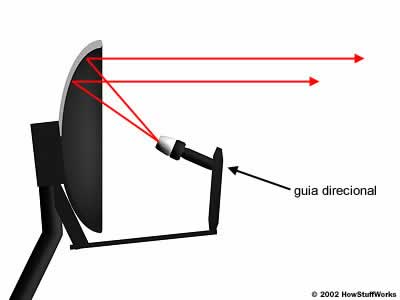
The curved plate reflects the energy of the directional guide, generating a narrow beam
The satellite dish, at the receiving end, cannot transmit information, but only receive it. The receiver dish works exactly the opposite of the transmitter. When a beam hits the curved plate, the parabola shape reflects the radio signal inward at a particular point, just as a concave mirror focuses light at a particular point.
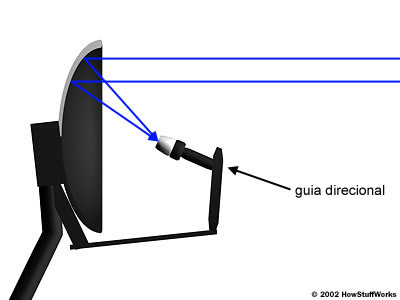
The curved plate focuses on the radio waves that reach the directional guide
In this case, the point is the directional guide of the antenna, which sends the signal to the receiving equipment. In an ideal configuration, there are no major obstacles between the satellite and the dish, so the dish receives a clear signal.
In some systems, the dish needs to pick up signals from two or more satellites at the same time. The satellites can be close enough that a normal satellite dish with a single directional guide can pick up signals from both. This compromises quality a little, because the dish is not aimed directly at one or more satellites. A new satellite dish design uses two or more guides to pick up signals from different satellites. As the beams from the different satellites reach the curved plate, they are reflected at different angles so that one beam hits one of the guides and the other hits a different guide.
The central element in the directional guide is the low noise blocking converter , or LNB (low noise blockdown). The LNB amplifies the radio signal that is reflected by the dish and filters out noise (radio signals that do not carry programming). The LNB sends the amplified and filtered signal to the satellite receiver inside the viewer’s home.
The receiver
The final component of the entire satellite TV system is the receiver . The receiver performs three essential tasks:
- it unscrambles the encrypted signal. In order to unblock the signal, the receiver needs the decoder chip for that programming package. The provider can communicate with the chip, via the satellite signal, to make the necessary adjustments to its decoding programs. The provider may occasionally send signals that interrupt the operation of illegal scramblers, such as an electronic countermeasure (ECM) against illegal users;
- it takes the MPEG-2 digital signal and converts it to an analog format that a regular television set can recognize. In the United States, receivers convert the digital signal into NTSC analog format. Some satellite dishes and receiver configurations can also output an HDTV signal;
- it extracts the individual channels from the broader satellite signal. When you change the channel on the receiver, it only sends the signal from that channel to your TV. Since the receiver broadcasts only one channel at a time, you cannot record a program while watching another. You also cannot watch two different channels on two TVs connected to the same receiver. To do these actions, which are standard on a conventional cable, you need to purchase an additional receiver;
Receivers also have several other features. They pick up a signal with the provider’s scheduling schedule and present that information in a programming guide displayed on the screen. Many receivers have channel blocking options by the user, and some have built-in digital video recorders (DVRs), which allows you to pause the live broadcast or record it to a hard drive.
While the digital satellite transmission service does not yet have some of the basic features of conventional cable (the ability to easily split signals between different TVs and VCRs, for example), the high quality of your image, the varied selection of programming and the expansion of service areas make it a good alternative for some people. With the growth of digital cable , which has also improved image quality and increased channel selection, the TV war is really heating up. Anything can happen in the next few years as these television providers struggle.